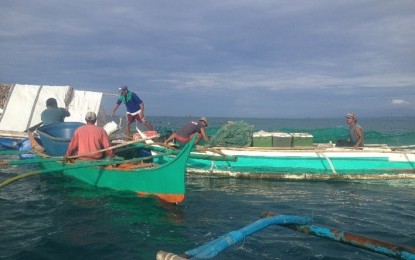
CONTAMINATION. Fishermen harvesting cultured milkfish in the coastal waters of Guiuan, Eastern Samar in this undated photo. The coastal area along with several bays in Eastern Visayas has been contaminated with red tide. (Photo courtesy of Bureau of Fisheries and Aquatic Resources)
TACLOBAN CITY – Red tide continues to thrive in Eastern Visayas with one more bay added to the long list of affected coastal areas in the region this year, the Bureau of Fisheries and Aquatic Resources has reported.
In an advisory issued Wednesday night, BFAR confirmed that red tide toxins are present in the coastal waters of Calubian, Leyte.
BFAR identified red tide contamination in the coastal waters of Guiuan, Eastern Samar; Villareal Bay in Samar; Cambatutay Bay in Tarangnan, Samar; coastal waters of Zumarraga, Samar; and coastal waters of Leyte, Leyte; Cancabato Bay in Tacloban City; Matarinao Bay stretching across the towns of General MacArthur, Hernani, Quinapondan, and Salcedo in Eastern Samar.
Also hit by red tide are coastal waters of Biliran in Biliran province; Carigara Bay — Babatngon, San Miguel, Barugo, Carigara, and Capoocan in Leyte; Irong-irong Bay in Catbalogan City, Samar; San Pedro Bay in Basey, Samar; Maqueda Bay in the towns of Jiabong, Motiong, Paranas, San Sebastian, Calbiga, Pinabacdao, and Hinabangan in Samar; and the coastal waters of Daram, Samar.
BFAR Assistant Director for Operations Juan Albaladejo said what has been happening in the Pacific Ocean has a direct impact on unpredictable weather conditions in Eastern Visayas.
“This started in the third quarter of the year where a mild El Niño causes a long dry out season with occasional heavy rainfall event triggers the upwelling of inner shallow bays bringing up the sediments laden with red tide microorganism cysts and then use the organic load that comes with the sediments to start the bloom,” Albaladejo said in a phone interview on Thursday.
“This occurred as a series of events in different inner bodies of water and further intensified by the ever-changing current patterns in these areas, hence, spreading the red tide blooms. These unusual but natural episodes continued until the rainy season,” he added.
BFAR said it issued the warning as precautionary advice to the public to refrain from gathering, selling, and eating all types of shellfish.
The fisheries bureau also banned the trading and consumption of Acetes sp. locally known as "alamang" harvested from said bays to avoid possible shellfish poisoning.
Local government units are advised to regulate the gathering, marketing, and transport of shellfish from the infested areas.
"Fish, squid, shrimp, and crab are safe to eat provided that they are fresh and washed thoroughly and internal organs such as gills and intestines are removed before cooking", the advisory added.
At least two children died and four of their family members were hospitalized last September after eating red tide infected green mussels in Bagacay village, Daram, Samar.
Killed by paralytic shellfish poisoning (PSP) were an eight-year-old boy and his three-year-old brother while four other family members were admitted at a hospital in Catbalogan City, Samar.
Red tide is a term used to describe a phenomenon where the water is discolored by high algal biomass or the concentration of algae. PSP occurs from ingesting bivalve shellfish (such as mussels, oysters, and clams) that contain toxins. (PNA)
